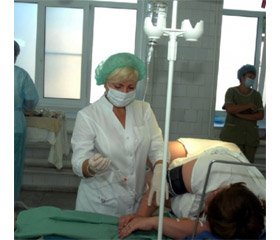Журнал «Медицина неотложных состояний» 1 (64) 2015
Вернуться к номеру
Paravertebral analgesia
Авторы: Sinitsyn M.N, Strokan A.N. - Feofaniya Clinical Hospital, State Administration of Affairs, Kyiv, Ukraine; P. L. Shupyk National Medical Academy of Postgraduate Education, Kyiv, Ukraine
Рубрики: Медицина неотложных состояний
Разделы: Клинические исследования
Версия для печати
thoracic paravertebral block, ultrasound guidance.
PVB is widely used in thoracic surgery, especially catheter method for prolonged anesthesia in postoperative period, in case of chest injuries with multiple fractures of ribs as a component of anesthesia for breast surgery.
The use of traditional technique.
As stated above, the use of classical technique for resistance loss without ultrasound verification use is associated with the complications development and failures of blocks, especially during PVS catheterization. There was performed 62 blocks on 10 cadavers in the study conducted by Luyet C. The implementation success was evaluated by the needle tip location under the computer tomography guidance. Using classical technique for resistance loss the block was successful only for 50%, whereas under ultrasound guidance - in 94% of cases [5].
The use of ultrasound verification
Ultrasonic transducer in relation to the transverse processes may be disposed laterally and medially; in transverse, sagittal and oblique directions. The mutual arrangement of the transducer and the needle, and therefore its visualization - in plane (longitudinally to transducer axis) and out of plane (transversally to transducer axis). Figure 2 shows the location options of the transducer and needle in the process of the PVB implementation.
Figure 2.Types of PVB with the use of ultrasound verification.
Figure 3.Transverse lateral PVB in plane.
Transverse lateral block in plane.
The transducer is located perpendicular to the backbone. Injection point is located lateral to the transverse process. The needle direction is along the transducer length. There are visualized on the monitor the thoracic vertebra, transverse process and pleura in a form of thin light strip. PVS is located between the transverse process and the pleura. This technique allows to trace the needle movement throughout the puncture implementation. The relative remoteness of the backbone allows to secure it from falling into the epidural space through the intervertebral foramen in the case of catheter techniques. Figure 3.
Figure 4. Sagittal lateral PVB out of plane.
Sagittal lateral block out of plane.
The transducer is located parallel to the backbone above transverse processes. Injection point is lateral to transverse processes. The needle direction is transverse to the transducer length. There are visualized transverse processes and pleura on the monitor. PVS is located above the pleura, between transverse processes. At the technical level this technique is more complicated and requires certain skills in spatial thinking, because needle visualization can be traced not along the whole length and there is a probability of pleural cavity puncture implementation.
Figure 5.Oblique medial PVB in plane.
Oblique medial block in plane.
The transducer is located obliquely at 45 ° with respect to the transverse axis of the backbone. Injection point is between transverse processes. The needle direction is along the transducer length. There are visualized the thoracic vertebra and pleura on the monitor. Figure 5. The advantage of this technique is the ability to observe the needle movement along the whole length. This method is the most adapted for PVS catheterization in comparison with other techniques. This is due to the fact that the needle is disposed at an acute angle and the catheter goes through minimal resistance during the movement [1].
Figure 6.Transverse medial PVB out of plane.
Transverse medial block out of plane.
With the use of this technique, the transducer is located between the transverse processes, perpendicular to the backbone. There are visualized the thoracic vertebra and pleura on the monitor. Injection point is located between the transverse processes, but the disadvantage consist of the complicated visualization, that is the feature of all blocks in out of plane mode. Figure 6.
Figure 7.Transverse medial PVB in plane.
Transverse medial block in plane.
The transducer has the identical to the previous block disposition, between the transverse processes, but the puncture is performed in plane mode. In contrast to the lateral transverse block, the injection point is located closer to the backbone. There are visualized the thoracic vertebra and pleura on the monitor. Figure 7.
Specialitiesof ultra-guided catheterization technique
PVS catheterization has its difficulties and the availability of ultrasound verification does not solve all tasks. Thus, according to the results of another study on cadavers conducted byLayet G., only 11 of 20 blocks performed with a catheter were successful. The catheter dispositions were as follows: epidurally in 6 cases, in pleural cavity in 1 case, and prevertebrally in 2 cases [4]. Prevertebral and intrapleural location of the catheter is not accompanied by the development of proper clinical effect. With the localization of the catheter in the epidural space an analgesia is achieved, however, there is a risk of complications that are specific to an epidural analgesia. The catheter twisting in paravertebral space is another type of the complications associated with catheterization. Flexible catheters are used to avoid this complication . The recommended length of the movement over the needle tip is 8.2mm. Taking into account the recommendations for disposition,60 catheters were disposed in PVS. None of the catheters was not twisted, disposed epidurally, intrapleural or prevertebrally [6].
Thus, PVB in combination with narcotic analgesics and NSAIDs is a reliable method for the postoperative protection, and the use of ultrasound verification allows to perform a block practically with no complications and with an efficiency over 100%.
AndriyStrokan, MaksymSynytsyn
Paravertebral analgesia.
Summary. The article gives a representation of the different methods of thoracic paravertebral block by ultrasound guidance.

